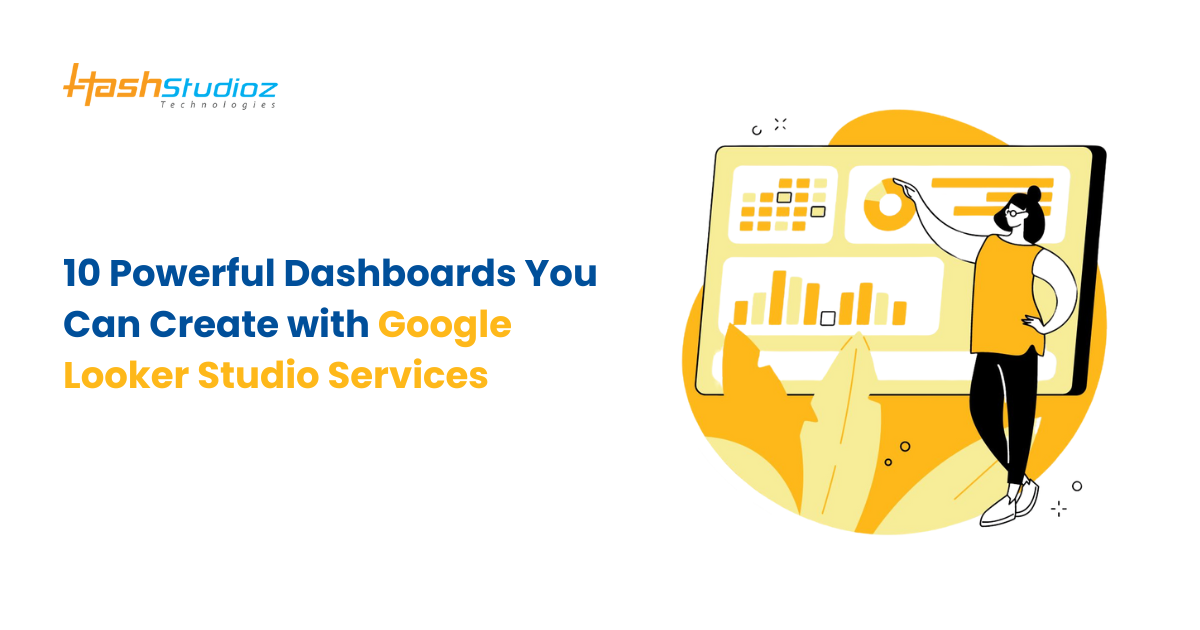science-technology

March 28,2025 • 4 min read
10 Powerful Dashboards You Can Create with Google Looker Studio Services

Organizations today thrive on data. But raw data alone isn’t enough. It needs to be visualized, interpreted, and shared meaningfully. This is where Google Looker Studio Services come in, offering dynamic dashboards that transform scattered data into actionable insights. In this article, we explore ten powerful dashboards you can create using Looker Studio and how they contribute to better decision-making.
What Are Google Looker Studio Services?
Google Looker Studio Services refer to professional offerings centered around Google's data visualization platform, Looker Studio. These services involve:
-
Designing custom dashboards
-
Integrating multiple data sources
-
Real-time reporting
-
Building scalable BI solutions
These services help businesses convert complex datasets into interactive, insightful, and shareable dashboards.
Benefits of Using Dashboards in Looker Studio
-
Centralized Reporting: View KPIs across departments in one place.
-
Customization: Build reports that match brand style and business needs.
-
Real-Time Insights: Data refreshes automatically.
-
Collaboration: Share live dashboards with teams or stakeholders.
-
Scalability: Easily scale for startups or enterprise-level data needs.
Top 10 Powerful Dashboards You Can Create with Google Looker Studio Services
1. Marketing Performance Dashboard
Track and visualize the effectiveness of marketing efforts across channels.
Features:
-
Ad spend and ROI
-
Conversion rates by campaign
-
Channel-specific performance (Google Ads, Facebook, etc.)
-
Cost per lead and customer acquisition cost
Use Case: Marketing managers can optimize budgets and strategies in real time.
2. Sales & Revenue Analytics Dashboard
Provides a clear picture of sales trends, pipeline health, and revenue streams.
Features:
-
Monthly and quarterly sales trends
-
Forecast vs. actual revenue
-
Top-performing sales reps
-
Product-wise sales breakdown
Use Case: Sales directors can track targets, identify gaps, and align sales strategies.
3. E-commerce Performance Dashboard
Crucial for online retailers, this dashboard integrates store data to monitor customer and product performance.
Features:
-
Total sales and transactions
-
Cart abandonment rate
-
Traffic sources and bounce rates
-
Average order value and repeat purchase rate
Use Case: E-commerce businesses can analyze purchase behavior and optimize user experience.
4. Customer Behavior & Journey Dashboard
Understand how customers interact with your brand at every touchpoint.
Features:
-
Funnel visualization
-
Heatmaps of user activity
-
Session duration and exit points
-
Customer segmentation by behavior
Use Case: CX teams can improve personalization strategies and customer satisfaction.
5. Social Media Analytics Dashboard
Measure the reach, engagement, and performance of social campaigns.
Features:
-
Post-level engagement metrics
-
Follower growth across platforms
-
Sentiment analysis
-
Social referral traffic
Use Case: Social media teams can fine-tune content strategies and demonstrate ROI.
6. SEO & Website Performance Dashboard
Combine Google Analytics and Google Search Console data to monitor website health.
Features:
-
Organic traffic and bounce rate
-
Keyword rankings and impressions
-
Page load time and technical SEO issues
-
User device and geographic data
Use Case: SEO specialists can identify content gaps and improve site visibility.
7. Financial Reporting Dashboard
Track financial KPIs with real-time accuracy to ensure fiscal control.
Features:
-
Profit & Loss (P&L) statements
-
Expense tracking by department
-
Budget vs. actual comparison
-
Cash flow trends
Use Case: CFOs and finance teams can quickly access financial health metrics and forecasts.
8. Project Management Dashboard
Ensure all projects are on track with milestones, timelines, and resource allocation.
Features:
-
Task completion status
-
Resource utilization
-
Budget tracking
-
Project risk assessments
Use Case: Project managers can enhance team productivity and meet delivery goals.
9. Product Performance Dashboard
Monitor how each product is performing in terms of sales, satisfaction, and lifecycle.
Features:
-
Product-specific revenue
-
Return and defect rates
-
Customer reviews and ratings
-
Inventory and stock levels
Use Case: Product managers can make data-backed decisions about discontinuation or development.
10. Executive Overview Dashboard
A high-level snapshot for the C-suite to track overall business health.
Features:
-
Cross-departmental KPIs
-
High-priority metrics like ARR, churn, and NPS
-
Growth trends and forecasts
-
Strategic initiative progress
Use Case: Executives can align strategies with measurable business outcomes.
Conclusion
Google Looker Studio Services are a game-changer for businesses seeking data clarity and faster decision-making. By building tailored dashboards, organizations can visualize KPIs, streamline operations, and align cross-functional teams. From marketing and sales to finance and executive strategy, the ten dashboards discussed here serve as a roadmap for leveraging Looker Studio to its fullest potential.
Gourav Sapra Details
User Profile
- Full name
- Gourav Sapra
- Email address
- gouravsapra24@gmail.com
- Join Date
- 2025-03-25
- State
- California
- City
- Altadena
- Pincode
- 91001-4735
- Address
- 161 W Altadena Dr, Unit 501 STE Altadena CA,
- Follow us on Facebook
- hashstudioz
- Follow us on Twitter
- hashstudioz
- Website Name
- https://www.hashstudioz.com/travel-technology-services.html
- Bio
- Hey, I am Gourav Sapra and I am a Technical Consultant and Content Creator by profession and working at HashStudioz Technologies.